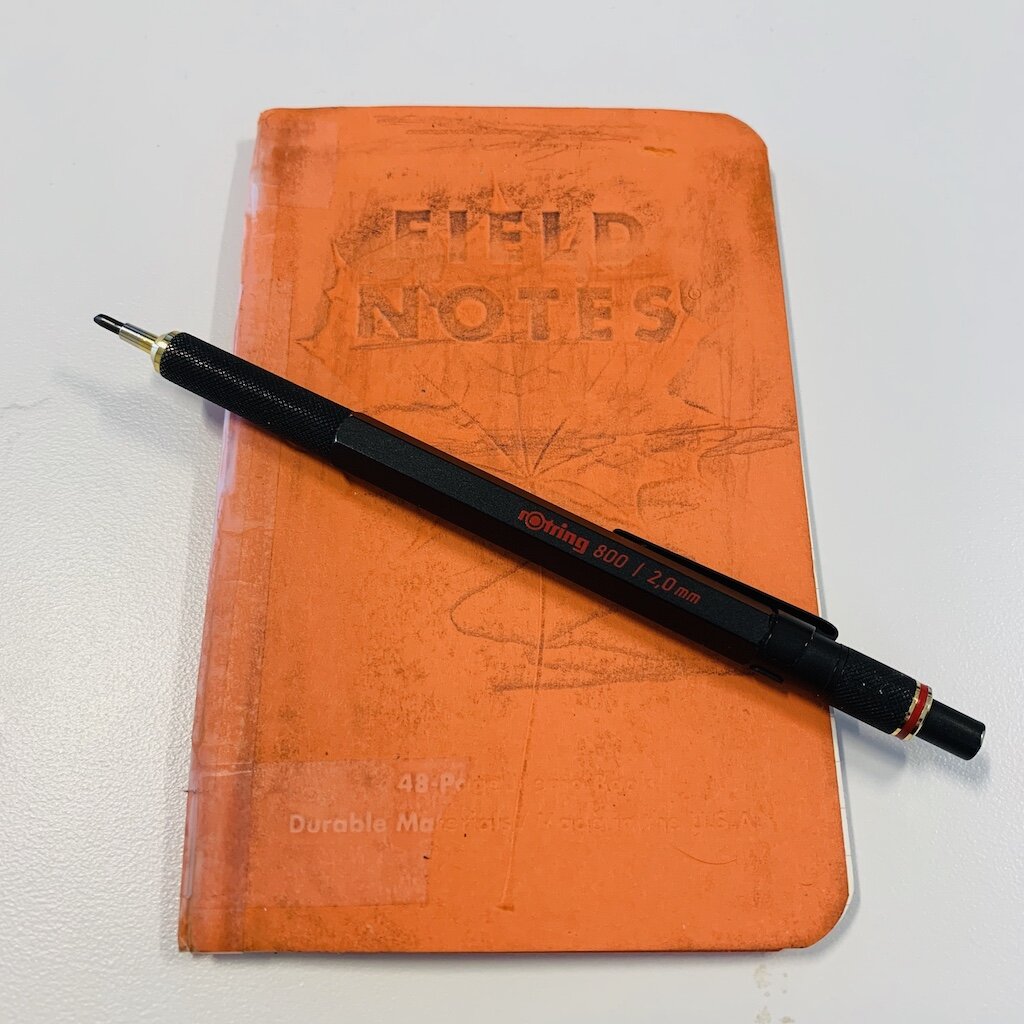(This is a guest post by Nick Folz. You can find more of Nick and his work on his blog, Smallberry Drive, Twitter, and Instagram.)
The Rotring 800 2mm Lead Holder is a master class in minimalism. It’s a knock advance instead of a clutch/drop system, it has no built in sharpener, there is no grade indicator. A case could easily be made against it, especially when grading on specs alone. Comparing this model against a Rotring Rapid Pro 2mm, or a Staedtler 925-35 would be a difficult sell. Both of those models are cheaper and are very fine lead holders, and on paper it is easy to write off the 800 as an expensive oddity. But line them up on a desk and I will pick up the 800 every time. Finesse, build quality, and design are one hell of a factor in person.
The 800 series has had a bit of a troubled past for Rotring, the early versions of the mechanical pencil entries (.5mm and .7mm) have a retractable lead sleeve. Lots of reviewers complained about this mechanism breaking lead internally, making the cleaning of it (which was never fun or easy) a near routine.
The 2mm model has no such sleeve, thank goodness. One of my favorite things about lead holders is their innate pocket friendly nature, which also cuts down on “whiz-bang” gimmicks like sliding sleeves and moving parts. I’m not bad mouthing features like those, I have a Rapid Pro .7mm that I LOVE because of it (Some of my best friends have sliding sleeves), but I also like the utilitarian nature of a stripped down tool.
That predisposition might explain a lot about why I love this pencil. It is everything it needs to be and nothing it’s not. No grade indicator, no tiny sharpener, the fanciest thing this pencil has is a clip, but that clip is substantial. Every part of this little machine is substantial. It is made entirely of metal and the parts do not shake or jiggle. It is machined perfection. Taking the 800 apart is not unlike a ritual, placing the finely designed parts and arranging them is a thing of beauty. Do all the parts need to be metal? No. Does it make a difference that they are? Yes.
The weight is nice, it has a heft to it that helps when writing or drawing for extended periods. If you like a lighter pencil then I would recommend the above mentioned Staedtler, which is aluminum. The brass construction of the 800 gives it that extra weight that I prefer in a drawing utensil. If someone asks to borrow a writing utensil it is an instant conversation piece. One co-worker has bought one for herself and others as gifts for friends and family.
The shape of the outer body is my favorite thing about this pencil. The hexagon body with circular knurled grip sections mix form and design in a symphony of utilitarian style. Rotring’s own Rapid Pro has a similar design but the hex shape isn’t as pronounced and the edges don’t extend past the circumference of the grip sections, so they don’t have the same effect, in aesthetics or function, as the 800. The hard edged middle hex section recalls the history of wood case pencils in a nice visual tribute, but the design also achieves that which was the point of the original design: it keeps the pencil from rolling around. I’m speaking plenty of sugar here, but when something about a design looks cool and adds to the function of the item, I swoon a bit.
Writing and drawing with the 800 is a pleasure. I use a softer lead, 2B, and the added weight of the pencil makes it very comfortable and the lead just glides across the page with little effort. My drawing style usually hides my love of lead: I pencil first, then lightly erase, ink, then erase again to hide all of the sloppy planning lines. I’ve tried to break myself of this and leave the planning pencil marks in on a few pieces. I like the overall look, but I mainly enjoy leaving the part the pencil played in the final product.
If you aren’t sure about lead holders and want to try one out, don’t let this one be your first choice.
If you have one lead holder that floats around your pen case, surfacing every now and again and you think “Oh yea, I should use that more,” only to grab a wood case pencil or a .5mm mechanical pencil instead, don’t buy another one.
If you have a few lead holders, have several packs of 2mm lead in various grades cluttering up your desk, have a lead smudged writing hand, and are looking for one lead holder to rule them all? DING DING DING DING. You found it.
(JetPens provided this product at no charge to The Pen Addict for review purposes.)
Enjoy reading The Pen Addict? Then consider becoming a member to receive additional weekly content, giveaways, and discounts in The Pen Addict shop. Plus, you support me and the site directly, for which I am very grateful.
Membership starts at just $5/month, with a discounted annual option available. To find out more about membership click here and join us!


















